Nikolai Astrup
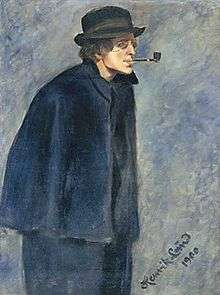
Henrik Lund (1900)
Nikolai Astrup (30 August 1880 – 21 January 1928) was a Norwegian painter.[1]
Biography
Astrup was born in Bremanger in Nordfjord, but grew up in Ålhus in Jølster where his father worked as a priest. He was the great-grandson of Nils Astrup, a one-term member of parliament. His father Christian wanted Nikolai, the oldest son, to become a priest as well, but Nikolai was more interested in drawing and painting. He studied these subjects in Oslo where he was a student at Backer popular school of painting.[2]
He later lived for a while in Paris and in Germany before returning to Jølster. He got married there and had 8 children. The economy was very tight and he struggled with poor health. Astrup died of pneumonia in 1928 at the age of 47 in Jølster's neighbouring municipality Førde.[3][4][5]
Astrup preferred clear, strong colors and usually made landscape art depicting his surroundings in Jølster. Having spent the majority of his life in Jølster, the Nordic landscape proved a strong influence and through his paintings he sought 'a national "visual language" that evoked the traditions and folklore of his homeland'.[6] His paintings describe an intimate interaction between nature and the built environment, characterized by bold lines and distinctive rich color. Astrup is regarded as a neo-romantic painter, but he also worked with woodcuts. Nikolai Astrup is looked upon as one of the greatest Norwegian artists from the early 1900s, and several of his paintings have been sold at auctions for approximately $500,000 USD. Astrup's works have been likened to those of his contemporary Edvard Munch, though Astrup's style has been described as being 'so much brighter – not just in colour, but also in mood'.[7]
Although well known in Norway, Astrup is little-known in the rest of the world. The first exhibition of his work outside of Norway is taking place at Dulwich Picture Gallery, London from 5 February - 15 May 2016. The exhibition will display over 90 oil paintings and prints, including works from private collections never exhibited before.[8]
Legacy
One wing at KODE, Bergen's largest museum for paintings, is devoted entirely to Astrup's work.[9]
Oil paintings
- Tun i Jølster, (1902)
- Stabbur i Jølster, (before 1905)
- Kvennagong, (before 1905)
- Prestegården, (before 1907)
- Grå vårkveld, (1907)
- Juninatt og gammelt vestlandstun, (before 1908)
- Kollen, (1908)
- Vårnatt i hagen, (1909)
- Jonsokbål, (1912–26)
- Vårstemning, (before 1914)
- Priseld, (1915)
- Revebjelle, (ca. 1920)
- Interiør med vugge, (ca. 1920)
 Svanøybukta
Svanøybukta Kl. 2 Julinat
Kl. 2 Julinat St. Hansbål ved Jølstervatnet
St. Hansbål ved Jølstervatnet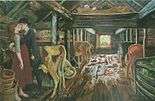 Fjøsfrieri
Fjøsfrieri Fugl på sten
Fugl på sten Klar juninatt
Klar juninatt Kornstaur
Kornstaur Kjerringa med lykta
Kjerringa med lykta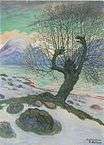 Martzmorgen
Martzmorgen Vårnatt og seljekall
Vårnatt og seljekall Soleienatt
Soleienatt Natt
Natt Prestegårdshagen
Prestegårdshagen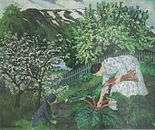 Rabarbra
Rabarbra Vårkveld ved Jølstervannet 1900
Vårkveld ved Jølstervannet 1900 'Vårnatt i hagen (1909)
'Vårnatt i hagen (1909)
Graphics
 Foss og bre
Foss og bre Liten kornstaur
Liten kornstaur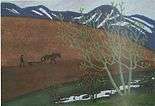 Plognatten
Plognatten St. Hansbål
St. Hansbål Maimåne
Maimåne Vinternatt
Vinternatt Gammel fisker
Gammel fisker Akt
Akt
References
- ↑ Fredheim, Arnt, ed. (2009). "Nikolai Astrup – maler". Store norske leksikon (in Norwegian). Oslo: Kunnskapsforlaget. Retrieved 15 November 2010.
- ↑ Arntzen, Jon Gunnar, ed. (2009). "Astrup". Store norske leksikon (in Norwegian). Oslo: Kunnskapsforlaget. Retrieved 15 November 2010.
- ↑ Øystein, Loge. "Nikolai Astrup – utdypning (NBL-artikkel)". In Helle, Knut. Norsk biografisk leksikon (in Norwegian). Oslo: Kunnskapsforlaget. Retrieved 15 November 2010.
- ↑ Fredheim, Arnt, ed. (2009). "Harriet Backer". Store norske leksikon (in Norwegian). Oslo: Kunnskapsforlaget. Retrieved 15 November 2010.
- ↑ Lange, Marit. "Harriet Backer – utdypning (NBL-artikkel)". In Helle, Knut. Norsk biografisk leksikon (in Norwegian). Oslo: Kunnskapsforlaget. Retrieved 15 November 2010.
- ↑ Dulwich Picture Gallery, "Nikolai Astrup: Painting Norway", Dulwich Picture Gallery, Nikolai Astrup: Painting Norway, 5 February 2016 - 15 May 2016, 11 Jan 2016.
- ↑ Jonathan Jones,"Nikolai Astrup: the lost artist of Norway", The Guardian, 30 December 2015.
- ↑ "Nikolai Astrup: Painting Norway", Dulwich Picture Gallery, Nikolai Astrup: Painting Norway, 5 February 2016 - 15 May 2016, 11 Jan 2016.
- ↑ http://www.ba.no/kultur/kode/hva-skjer-i-bergen/disse-tegningene-har-aldri-blitt-vist/s/5-8-259091
Literature
- Loge, Øystein (1986). Gartneren under regnbuen (in Norwegian). Oslo. ISBN 82-90646-05-4.
- Wexelsen, Einar; Danbolt, Gunnar; Loge, Øystein (2005). Nikolai Astrup – Tilhørighet og identitet (in Norwegian). Oslo. ISBN 82-7393-147-1.
- Kristiansen, Runar (1998). Edvard Munch, Nikolai Astrup, Rolf Nesch, Ludvig Eikaas (in Norwegian). Jølster. ISBN 82-91882-01-0.
External links
| Wikimedia Commons has media related to Nikolai Astrup. |
- nikolai-astrup.no (Norwegian)
- astruptunet.com (Norwegian)
- NRK Sogn og Fjordane on Astrup (Norwegian)